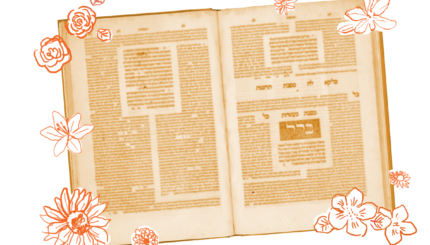In recent years, some Jewish groups, especially the Jewish Renewal movement, have begun incorporating guided meditation into their worship and spiritual life. The following meditation was written for Tashlikh, the Rosh Hashanah ritual in which sins are symbolically tossed away, but it is appropriate for any time during the High Holiday season. Reprinted with permission from Ma’yan: The Jewish Women’s Project.
We begin this meditation by standing in mountain pose. So, make sure that:
-
Your feet are about shoulder-width apart
-
Your feet are pressing evenly into the floor
-
Your knees are relaxed
-
Your shoulders are loose and that your arms are dangling by your sides
-
Your facial muscles are softened
-
Your spine makes a straight line from your stomach to your neck, pulling up to a point above your head.
-
Your arms are stretched straight by your sides.
Roots
Take a deep breath in through your nose and out through your mouth to secure this position. With each breath afterwards, see if you can notice tiny adjustments you can make to deepen the posture.
 In these next breaths, begin to imagine roots growing from all different parts of your feet, reaching deep into the ground. Imagine that these roots are pulling your feet down flat into the soil, supporting you-see if you can feel them from your toes, your heels, your arches, and the ball of your feet. Relax your arms, straighten your spine and breathe.
In these next breaths, begin to imagine roots growing from all different parts of your feet, reaching deep into the ground. Imagine that these roots are pulling your feet down flat into the soil, supporting you-see if you can feel them from your toes, your heels, your arches, and the ball of your feet. Relax your arms, straighten your spine and breathe.
The Past Year
Now that we’re in a relaxed position, start to think back through this past year. Let images enter and exit your mind-small moments, meaningful moments, smells, pictures and faces. Think back now to last Elul [the month preceding Rosh Hashanah], last September: where were you at the last High Holiday cycle? What promises had you made? What goals did you have for the coming year?
Move now into late September and October, the middle of fall, the Hebrew month of Tishrei; the holiday of Sukkot and the time for harvesting. What kinds of benefits did you reap this year? Financial? Educational? Experiential? See if you can recall them now.
Think now about last November, roughly the Hebrew month of Heshvan. Late fall, colder weather. The natural world slowly moving from bountiful to barren as the winter moves in, so that the cycle can begin again in the spring. Think now about changes that you made in your life this year. What patterns did you break? What new work did you take on?
Move slowly from November into December, the Hebrew month of Kislev, the month that holds Hanukkah, the holiday of lights and miracles. In what ways did you bring light or goodness into the world this year? What miracles happened in your life this year?
Then think back to last January and February; first, the Hebrew month of Tevet, the conclusion of Hanukkah.
Then, the month of Shevat, the month that contains Tu Bishevat, the festival of the trees, a time for planting. Think about new projects that you started this year, new plans that you made, “seeds” that you planted for your or your family’s future.
Move from late February into March, the Hebrew month of Adar and the ending of winter. During Adar, we celebrate Purim, a festival of fun and revelry. Think about the joy that came into your life this year? In what ways were you silly? Can you think of moments when you laughed?
From March to April, from Adar to Nisan, the month of spring. The time we celebrate Pesach [Passover] and think about renewal, rebirth, and newfound freedom. What struggles concluded in your life this year? Were there issues or difficulties in your life that you were able to overcome?
Next, think back to last May, the Hebrew month of Iyar. In the secular year, a time for closings and endings. Think about endings that occurred in your life this year. What issues, relationships, situations came to a close during the past 12 months?
Move from May into June and into the month of Sivan, the month that holds the holiday of Shavuot, the holiday that celebrates our receiving of the Torah. Think about learning that you did during the year. What new things did you learn this year, and what effect did they have on you?
From June into July and August; through the Hebrew months of Tammuz and Av; hot and humid weather; slowing of activity and some time for rest; in the Hebrew calendar, these months are a time to think about history and loss; think about losses in your life this past year. In what ways did you grieve?
And here we are in the new year, making new promises and setting new goals. So before we do that, take a few moments and deep breaths to remember the journey of the past year.
Adar
Pronounced: uh-DAHR, Origin: Hebrew, Jewish month usually coinciding with February-March.
Elul
Pronounced: eh-LULE, Origin: Hebrew, Jewish month usually coinciding with August-September.
Pesach
Pronounced: PAY-sakh, also PEH-sakh. Origin: Hebrew, the holiday of Passover.
Rosh Hashanah
Pronounced: roshe hah-SHAH-nah, also roshe ha-shah-NAH, Origin: Hebrew, the Jewish new year.
Sukkot
Pronounced: sue-KOTE, or SOOH-kuss (oo as in book), Origin: Hebrew, a harvest festival in which Jews eat inside temporary huts, falls in the Jewish month of Tishrei, which usually coincides with September or October.
Tammuz
Pronounced: tah-MOOZ (oo as in boot), Origin: Hebrew, Jewish month that usually coincides with June or July.

